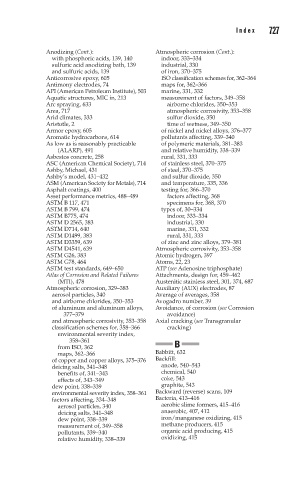Page 777 - Corrosion Engineering Principles and Practice
P. 777
726 I n d e x I n d e x 727
Anodizing (Cont.): Atmospheric corrosion (Cont.):
with phosphoric acids, 139, 140 indoor, 333–334
sulfuric acid anodizing bath, 139 industrial, 330
and sulfuric acids, 139 of iron, 370–375
Anticorrosive epoxy, 605 ISO classification schemes for, 362–364
Antimony electrodes, 74 maps for, 362–366
API (American Petroleum Institute), 503 marine, 331, 332
Aquatic structures, MIC in, 213 measurement of factors, 349–358
Arc spraying, 633 airborne chlorides, 350–353
Area, 717 atmospheric corrosivity, 353–358
Arid climates, 333 sulfur dioxide, 350
Aristotle, 2 time of wetness, 349–350
Armor epoxy, 605 of nickel and nickel alloys, 376–377
Aromatic hydrocarbons, 614 pollutants affecting, 339–340
As low as is reasonably practicable of polymeric materials, 381–383
(ALARP), 491 and relative humidity, 338–339
Asbestos concrete, 258 rural, 331, 333
ASC (American Chemical Society), 714 of stainless steel, 370–375
Ashby, Michael, 431 of steel, 370–375
Ashby’s model, 431–432 and sulfur dioxide, 350
ASM (American Society for Metals), 714 and temperature, 335, 336
Asphalt coatings, 400 testing for, 366–370
Asset performance metrics, 488–489 factors affecting, 368
ASTM B 117, 471 specimens for, 368, 370
ASTM B 799, 474 types of, 30–334
ASTM B775, 474 indoor, 333–334
ASTM D 2565, 383 industrial, 330
ASTM D714, 640 marine, 331, 332
ASTM D1499, 383 rural, 331, 333
ASTM D3359, 639 of zinc and zinc alloys, 379–381
ASTM D4541, 639 Atmospheric corrosivity, 353–358
ASTM G26, 383 Atomic hydrogen, 397
ASTM G78, 464 Atoms, 22, 23
ASTM test standards, 649–650 ATP (see Adenosine triphosphate)
Atlas of Corrosion and Related Failures Attachments, design for, 459–462
(MTI), 478 Austenitic stainless steel, 301, 374, 687
Atmospheric corrosion, 329–383 Auxiliary (AUX) electrodes, 87
aerosol particles, 340 Average of averages, 358
and airborne chlorides, 350–353 Avogadro number, 39
of aluminum and aluminum alloys, Avoidance, of corrosion (see Corrosion
377–379 avoidance)
and atmospheric corrosivity, 353–358 Axial cracking (see Transgranular
classification schemes for, 358–366 cracking)
environmental severity index,
358–361 B
from ISO, 362
maps, 362–366 Babbitt, 632
of copper and copper alloys, 375–376 Backfill:
deicing salts, 341–348 anode, 540–543
benefits of, 341–343 chemical, 540
effects of, 343–349 coke, 543
dew point, 338–339 graphite, 543
environmental severity index, 358–361 Backward (reverse) scans, 109
factors affecting, 334–348 Bacteria, 413–416
aerosol particles, 340 aerobic slime formers, 415–416
deicing salts, 341–348 anaerobic, 407, 412
dew point, 338–339 iron/manganese oxidizing, 415
measurement of, 349–358 methane producers, 415
pollutants, 339–340 organic acid producing, 415
relative humidity, 338–339 oxidizing, 415

